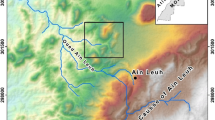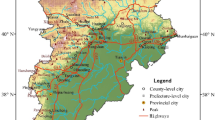Abstract
In many spatial interpolation fields, high accuracy surface modeling (HASM) has yielded better accuracy than classical interpolation methods. The Gaussian equation is the core of the HASM algorithm; The current version of the HASM method builds the Gaussian equation in Cartesian coordinates and, computes the two partial derivatives of the surface in the horizontal and vertical directions for each grid. In this paper, a modified HASM method is proposed that integrates flow paths to improve the original HASM methodology. The modified HASM approach involves two steps. The first step generates an initial DEM, which is used to compute the flow path. Then, the second step is conducted based on scatter points and the flow direction. The output from this step is better than the initial DEM. First, we used a theoretical mathematical surface to validate the correctness of the modified model. Then, we chose a small study area where the topography is affected by hydrological erosion for analysis. The test results showed that the modified HASM method constructed a DEM with low MAE and RMSE values compared to those of traditional methods, and it more accurately characterized topographic features. Finally, a relatively gently sloping area was selected to validate that the applicability of the new method in other areas.







Similar content being viewed by others
References
Aguilar FJ, Agüera F, Aguilar MA, Carvajal F (2005) Effects of terrain morphology, sampling density, and interpolation methods on grid DEM accuracy. Photogramm Eng Remote Sens 71(7):805–816
Burrough PA, McDonnell RA (1998) Principles of geographical information systems. Oxford University Press, New York
Chaplot V, Darboux F, Bourennane H, Leguédois S, Silvera N, Phachomphon K (2006) Accuracy of interpolation techniques for the derivation of digital elevationmodels in relation to landform types and data density. Geomorphology 77(1–2):126–141
Chen CF, Li YY, Yue TX (2013) Surface modeling of DEMs based on a sequential adjustment method. Int J Geogr Inf Sci 27(7):1272–1291
Claessens et al (2005) DEM resolution effects on shallow landslide hazard and soil redistribution modelling. Earth Surf Process Landf 30(4):461–477
Fisher P (1991) First experiments in viewshed uncertainty: the accuracy of the viewshed area. Photogramm Eng Remote Sens 57(10):1321–1327
Golub GH, Van Loan CF (2009) Matrix computations. Posts & Telecom Press, Beijing
Goovaerts P (2000) Geostatistical approaches for incorporating elevation into the spatial interpolation of rainfall. J Hydrol 228(1–2):113–129
Henderson DW (1998) Differential geometry. Prentice-Hall, London
Hunter GJ, Goodchild MF (1997) Modeling the uncertainty of slope and aspect estimates derived from spatial databases. Geogr Anal 29:35–49
Hutchinson MF, Gallant JC (2000) Digital elevation models and representation of terrain shape. In: Wilson JP, Gallant JC (eds) Terrain analysis: principles and applications. Wiley, New York, pp 29–50
Kawabata D et al (2010) Landslide susceptibility mapping using geological data, a DEM from ASTER images and an artificial neural network (ANN). Geomorphology 113(1–2):97–109
Li JH, Chen WJ (2005) A rule-based method for mapping Canada's wetlands using optical, radar and DEM data. Int J Remote Sens 26(22):5051–5069
Liu XJ et al (2004) A study of accuracy and algorithms for calculating slope and aspect based on grid digital elevation model (DEM). Acta Geodaetica Et Cartographic Sinica 33:258–263
Lu YG, Wong DW (2008) An adaptive inverse-distance weighting spatial interpolation technique. Comput Geosci 34(9):1044–1055
Moore ID, Grayson RB, Ladson AR (1991) Digital terrain modelling: a review of hydrological, geomorphological, and biological applications. Hydrol Process 5(1):3–30
Murphy PNC, Ogilvie J, Meng FR, Arp P (2008) Stream network modelling using lidar and photogrammetric digital elevation models: a comparison and field verification. Hydrol Process 22(12):1747–1754
O’Callaghan JF, Mark DM (1984) The extraction of drainage networks from digital elevation data. Computer and Image Processing 28:323–344
Pike RJ (2000) Geomorphometry—diversity in quantitative surface analysis. Prog Phys Geogr 24:1–20
Somasundaram D (2005) Differential geometry. Alpha Science International Ltd., Harrow
Toponogov VA (2006) Differential geometry of curves and surfaces. Birkhaeuser Boston, New York
Xiong LY, Tang GA, Yuan BY, Lu ZC, Li FY, Zhang L (2014) Geomorphological inheritance for loess landform evolution in a severe soil erosion region of loess plateau of China based on digital elevation models. Sci China Earth Sci 57(8):1944–1952
Yue TX (2011) Surface modeling: high accuracy and high speed methods. CRC Press, New York
Yue TX, Wang SH (2010) Adjustment computation of HASM: a high-accuracy and high-speed method. Int J Geogr Inf Sci 24(11):1725–1743
Yue TX, Du ZP, Song DJ (2007) A new method of surface modelling and its application to DEM construction. Geomorphology 91(1–2):161–172
Yue TX, Chen CF, Li BL (2010) An adaptive method of high accuracy surface modeling and its application to simulating elevation surfaces. Trans GIS 14(5):615–630
Yue TX, Chen CF, Li BL (2012) A high accuracy method for filling SRTM voids and its verification. Int J Remote Sens 33(9):2815–2830
Zhao N, Yue TX, Zhao MW, du ZP, Fan ZM, Chen CF (2014) Sensitivity studies of a high accuracy surface modeling method. Sci China Earth Sci 57(10):2386–2396
Zhao MW et al (2015) Parallel algorithm of a modified HASM and its application in DEM construction. Environ Earth Sci 74:6551–6561
Acknowledgements
We are thankful for all of the helpful comments provided by the reviewers. This study was supported by the Natural Science Foundation of China (41701450, 41571398, 41501445), Key Project of Natural Science Research of Anhui Provincial Department of Education (KJ2016A536), Research project on the application of public welfare Technology in Anhui Province (1704f0704064), and Anhui Provincial Natural Science Foundation of China (1608085QD77).
Author information
Authors and Affiliations
Corresponding author
Additional information
Communicated by: H. A. Babaie
Rights and permissions
About this article
Cite this article
Jiang, L., Zhao, M., Yue, T. et al. A modified HASM algorithm and its application in DEM construction. Earth Sci Inform 11, 423–431 (2018). https://doi.org/10.1007/s12145-018-0341-y
Received:
Accepted:
Published:
Issue Date:
DOI: https://doi.org/10.1007/s12145-018-0341-y




